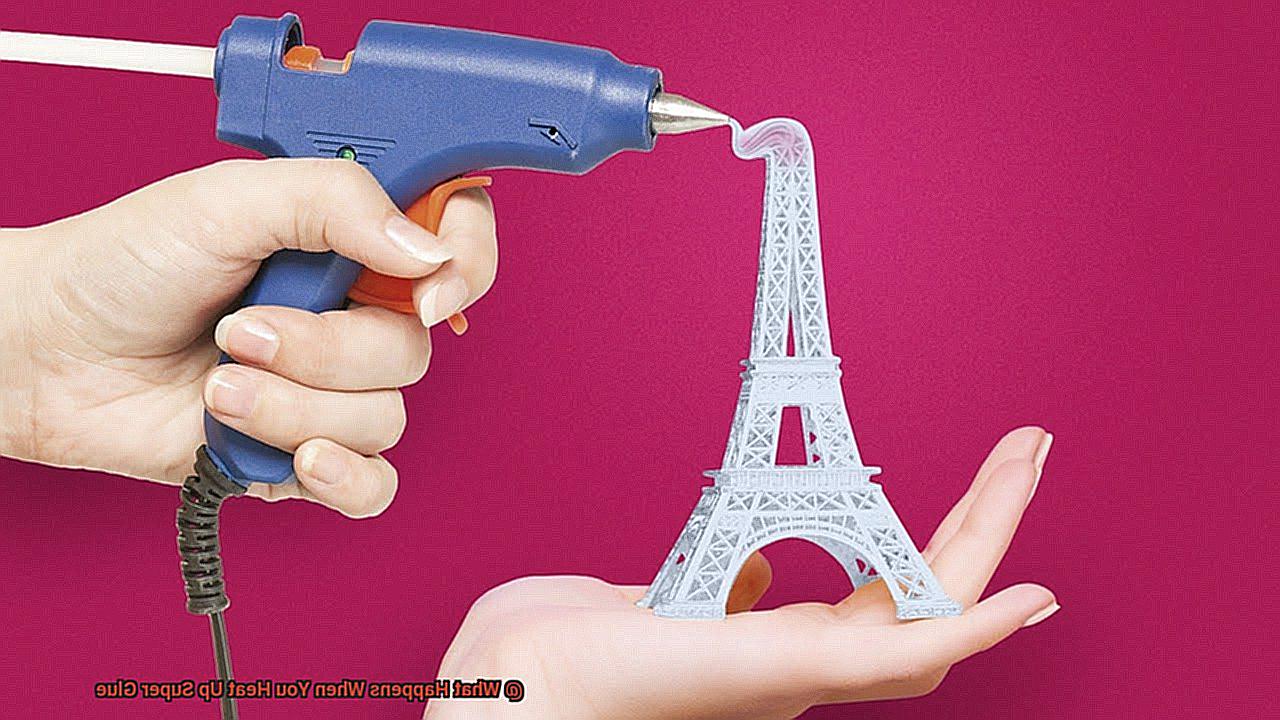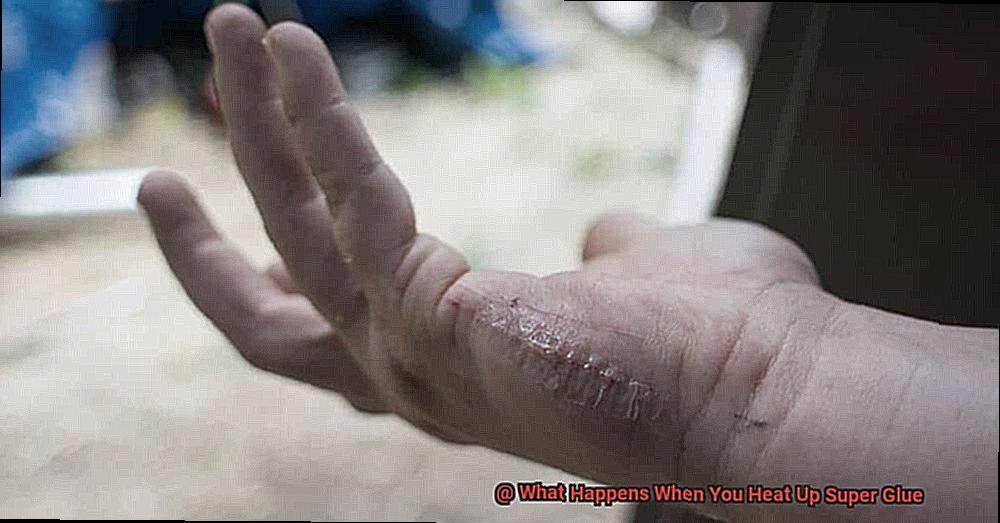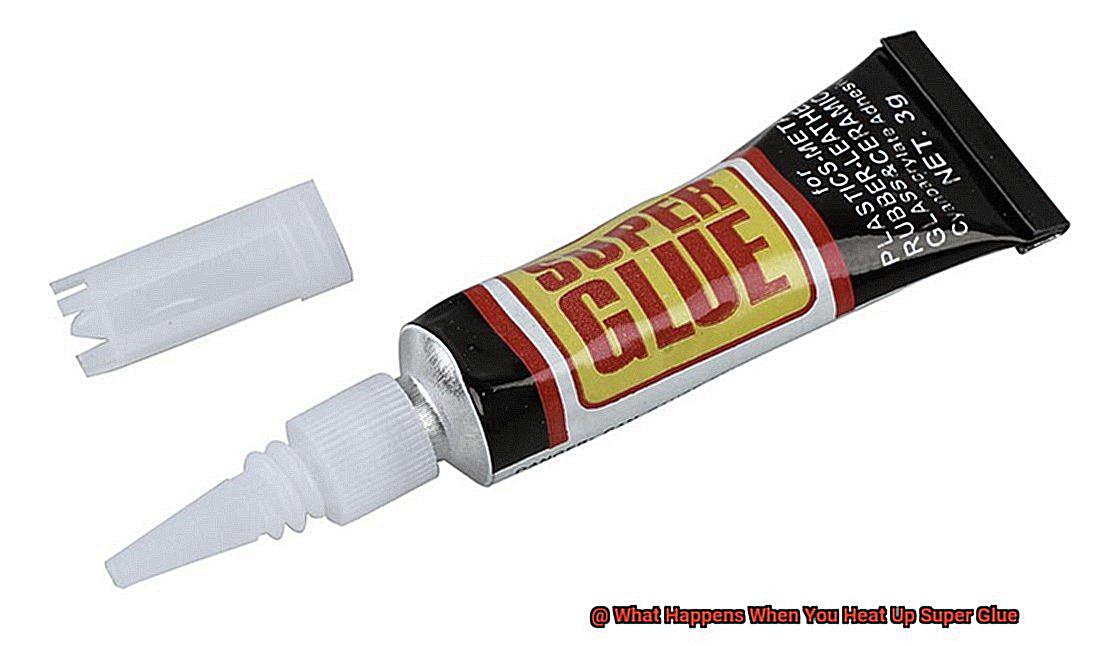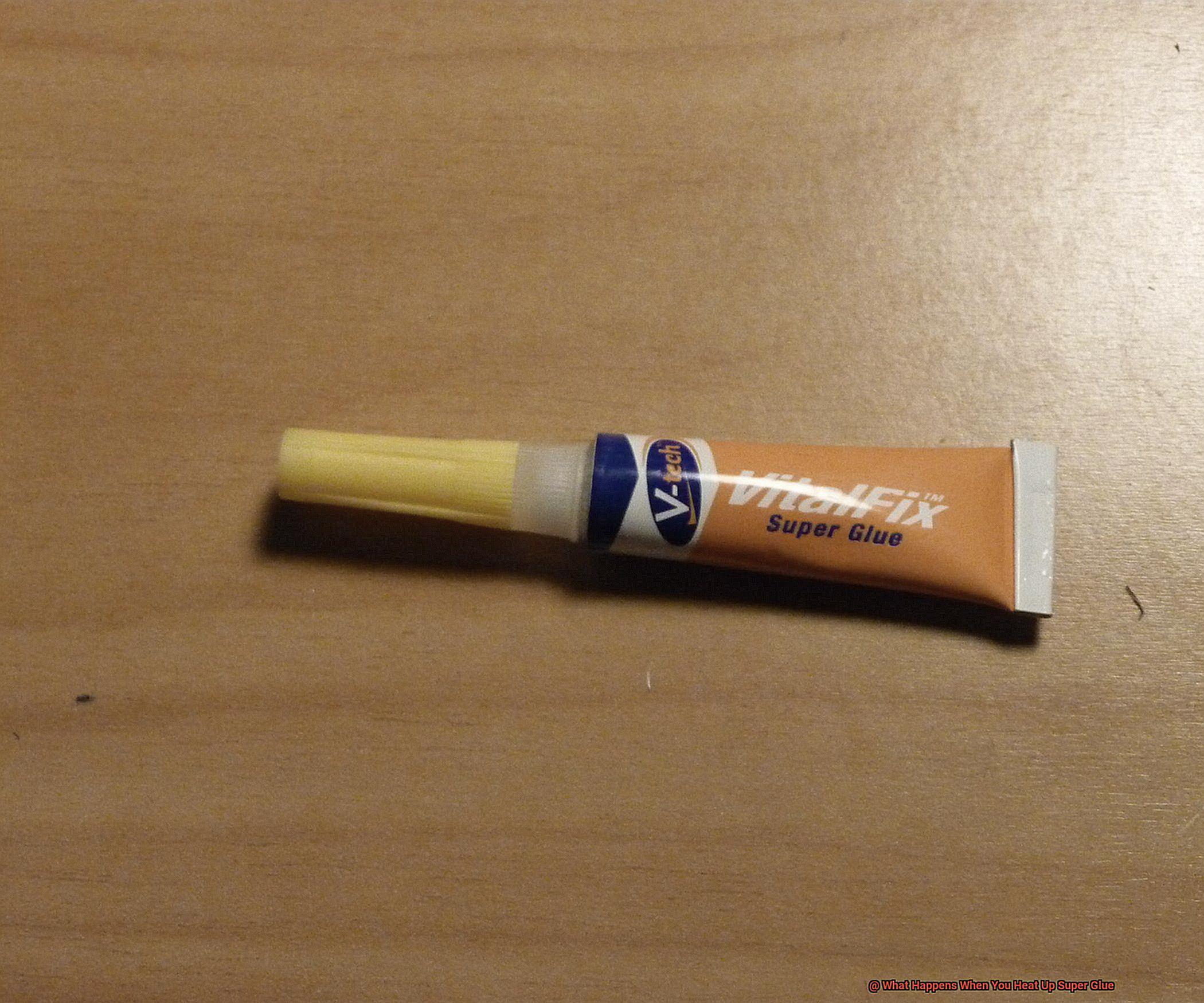Got a broken item? Don’t sweat it, my friend. When life gets sticky, super glue comes to the rescue with its magical bonding powers and lightning-fast drying abilities. But have you ever pondered what happens when you crank up the heat on this extraordinary adhesive? Brace yourself for a mind-blowing journey as we dive deep into the science behind the mesmerizing reactions that turn ordinary super glue into something extraordinary.
As temperatures soar, super glue unveils a world of captivating transformations. From its humble yet potent composition to the spellbinding chemical reactions that unfold, get ready to unravel the mysteries and discover the hidden wonders that lie within this unassuming tube of adhesive. So, grab a seat, buckle up, and prepare to be captivated by the enigmatic effects that emerge when we heat up super glue.

What is Super Glue?
Contents
- 1 What is Super Glue?
- 2 Temperature at Which Super Glue Starts to Break Down
- 3 Potential Health Hazards of Heating Super Glue
- 4 How Heat Affects the Consistency of Super Glue
- 5 Foaming Reaction of Heated Super Glue
- 6 Toxic Fumes from Overheating Super Glue
- 7 Permanent Alteration of Structure When Cooled Down
- 8 Tips for Safely Heating Up Super Glue
- 9 Conclusion
Super glue, scientifically known as cyanoacrylate adhesive, is a remarkable and versatile adhesive that has garnered widespread acclaim for its rapid bonding and formidable strength. Derived from the chemical compound cyanoacrylate, this adhesive forms a tenacious bond between a wide array of materials. In this comprehensive exploration, we will delve into the captivating world of super glue, examining its intricate composition, exceptional characteristics, and crucial precautions.
Composed of carbon, hydrogen, and oxygen atoms, super glue’s molecular structure undergoes a process called polymerization. When exposed to moisture, such as atmospheric humidity or surface dampness, these molecules undergo a remarkable reaction, generating robust intermolecular forces that seamlessly unite the materials.
One of super glue’s most notable attributes is its astonishing speed of bonding. Within mere seconds or minutes of application, it forges an almost instantaneous connection that frequently surpasses the strength of the materials being joined. This extraordinary attribute makes it an ideal choice for an extensive range of applications, including bonding plastic, rubber, metal, ceramic, wood, and even some fabrics.
Another noteworthy quality of super glue lies in its resilience against extreme temperatures. It exhibits an impressive capacity to endure temperatures as low as -40 degrees Fahrenheit (-40 degrees Celsius) and as high as approximately 180 degrees Fahrenheit (82 degrees Celsius). However, it is essential to recognize that excessive heat can compromise the adhesive’s performance and diminish its bond strength.
When subjected to temperatures exceeding 150 degrees Celsius (300 degrees Fahrenheit), super glue begins to deteriorate and lose its adhesive properties. This degradation transpires due to the breakdown of the cyanoacrylate compounds present within the adhesive. Heating super glue can also result in the emission of irritating fumes and a transformation into a more liquid consistency.
Prudent handling of super glue is paramount in order to evade inadvertent bonding. In the event of accidental contact with skin or other surfaces, it is advisable to seek medical counsel rather than forcibly separating the bonded areas.
Temperature at Which Super Glue Starts to Break Down
Prepare to be amazed as we delve into the depths of this adhesive superhero’s fiery fate and uncover the temperature at which it starts to break down.
The Molecular Marvels of Super Glue:
Super glue, also known as cyanoacrylate adhesive, is a fast-drying adhesive that forms an unbreakable bond between materials. Its molecular structure, composed of carbon, hydrogen, and oxygen atoms, resembles a tightly woven web ready to spring into action.
When moisture is introduced, these molecules undergo a miraculous transformation called polymerization – joining hands in an intricate dance that creates intermolecular forces and binds materials together with an iron grip.

The Power of Time:
One of super glue’s remarkable abilities is its lightning-fast bonding speed. In just moments after application, it forms an unyielding connection that often surpasses the strength of the materials it binds. Witnessing this magical spell being cast is like watching plastic, rubber, metal, ceramic, wood, and fabrics fuse together in perfect harmony.
The Temperature Threshold:
Alas, even the mightiest adhesive has its limits in the face of extreme temperatures. While super glue laughs off freezing cold temperatures as low as -40 degrees Fahrenheit (-40 degrees Celsius), it begins to crumble under the pressure once temperatures soar above 300 degrees Fahrenheit (150 degrees Celsius).
At these scorching heights, the cyanoacrylate compounds within start to break down, weakening the bond and leaving materials vulnerable to separation.
But what about those in-between temperatures? As the temperature rises from room temperature towards its threshold, super glue gradually loses its grip. Around 180 degrees Fahrenheit (82 degrees Celsius), its performance begins to suffer, and the bond created may weaken or fail completely.
Higher temperatures can cause the adhesive to degrade more rapidly, leading to a brittle bond that is less effective in holding materials together, especially under stress or strain.
The Fumes of Defeat:
In addition to losing its adhesive properties, heating super glue can release irritating fumes – a final breath before succumbing to the heat. It’s crucial to handle super glue with care and seek professional aid if you find yourself entangled in its sticky grasp.
Conclusion:
Super glue’s battle against high temperatures is a cautionary tale that highlights the importance of understanding its limits. To avoid compromising the integrity of a bond, it is advisable to keep bonded materials away from excessive heat sources. When faced with elevated temperatures, it’s best to utilize specialized high-temperature adhesives instead of relying on super glue’s superheroic powers.
Potential Health Hazards of Heating Super Glue
Today, we are going to uncover the potential health hazards of heating super glue. While this adhesive superhero is renowned for its quick bonding abilities, it holds a hidden danger when exposed to heat. So, grab your safety goggles and let’s dive into the sizzling world of heated super glue.
Toxic Fumes:
When super glue meets heat, it releases toxic fumes that can pose risks to our health. These fumes contain formaldehyde, a respiratory irritant notorious for its adverse effects. Inhaling these fumes can lead to coughing, shortness of breath, throat irritation, and even chest tightness.
Prolonged Exposure:
Continued exposure to heated super glue fumes can result in more severe respiratory problems. Over time, conditions such as bronchitis and asthma may develop, causing long-term discomfort and affecting your quality of life.
Skin Hazards:

Remember, your skin is not impervious to the dangers of heated super glue. Exposing it to high temperatures can cause painful burns or skin irritation due to the heat generated. Imagine peeling off a layer of glue from your skin; not exactly a pleasant experience.
Splatters and Spews:
Heating super glue can be a recipe for disaster if not handled with caution. The intense heat can cause the glue to splatter or spew out unexpectedly, putting you at risk for burns or eye injuries. Shield yourself and others from potential accidents by using protective gear.
Handling with Care:
To prevent potential health hazards, it’s essential to handle super glue with care and avoid subjecting it to high temperatures. Store it in a cool and dry place away from heat sources, and never attempt to heat it intentionally.
How Heat Affects the Consistency of Super Glue
Today, we’re delving into the scorching topic of how heat affects the consistency of super glue. Whether you’re a DIY enthusiast or simply curious about the inner workings of this adhesive superhero, this article will provide you with all the sizzling details you need to know.
Heat and Super Glue: A Melting Affair:
The Chemistry Behind It:
Super glue, also known as cyanoacrylate adhesive, wields its power by bonding quickly and strongly when it comes into contact with moisture. However, when exposed to heat, the chemical bonds in super glue break down, causing it to become more liquid-like and lose its viscosity.
Melting Point Madness:
The melting point of super glue usually ranges from 80 to 100 degrees Celsius (176 to 212 degrees Fahrenheit). Once super glue reaches this temperature threshold, it undergoes a drastic transformation. It becomes less effective at bonding materials together, as the melted glue may not adhere as strongly or dry properly.
Beware of Toxic Fumes:
As if melting weren’t enough trouble, heating super glue beyond its melting point can release fumes that are irritating to the eyes, nose, and throat. To ensure safety, always use super glue in a well-ventilated area and avoid exposure to excessive heat or open flames.
The Chilling Effects of Cold Temperatures:
Brittle Bonding:
Extreme cold temperatures can turn super glue into a fragile companion. When faced with freezing temperatures, super glue becomes brittle and loses its flexibility. The moisture within the adhesive freezes, weakening the bond between materials.
Store at Room Temperature:
To maintain the adhesive properties of super glue, it’s crucial to store it at room temperature. Avoid exposing it to extreme cold that could jeopardize its effectiveness.
Beyond Consistency: Shelf Life Matters:
High temperatures can hasten the degradation of cyanoacrylate molecules within super glue over time. To ensure its longevity, store super glue in a cool and dry place, away from heat sources and direct sunlight.
Foaming Reaction of Heated Super Glue

The foaming reaction of heated super glue is a fascinating phenomenon that showcases the power of chemistry in unexpected ways. When you heat up super glue, get ready for a mind-blowing (not literally, of course) transformation that will leave you in awe.
Super glue contains a powerful adhesive called cyanoacrylate. This incredible substance forms strong bonds with moisture, making it the go-to solution for all your sticky situations. But what happens when you introduce heat into the equation? Hold on tight because things are about to get bubbly.
As the glue is heated, the cyanoacrylate molecules start to break down, releasing trapped gases in the process. These gases, my friends, are water vapor and carbon dioxide. As they escape from the glue, they create an extravaganza of foam. It’s like a party in a tube. The glue rapidly expands and transforms into a bubbly foam-like substance, which can take on a white or yellowish hue depending on the specific formulation of the super glue.
But here’s the thing: this foaming reaction is not just visually stunning; it’s also an exothermic process. That means it releases heat as it occurs. And this additional heat only intensifies the breakdown of cyanoacrylate molecules and accelerates the foaming process. Talk about a hot mess.
Now, before you grab your blowtorch to create a gluey volcano experiment, let me issue a word of caution. Heating super glue can be dangerous. The expanding foam can splatter or release hot gases that could cause burns or other injuries. Plus, here’s another bummer – when super glue foams, it loses its adhesive properties. So if you’re looking for a strong and reliable bond, heating is definitely not the way to go.
So there you have it, the foaming reaction of heated super glue. It’s a fascinating phenomenon that showcases the power of chemistry in unexpected ways. Just remember to handle heated super glue with care, and save the heat for your morning coffee instead.
Toxic Fumes from Overheating Super Glue
Super glue, that fast-acting adhesive that bonds almost anything in a blink of an eye, can become a dangerous source of toxic fumes when overheated. The chemical composition of the glue breaks down under high temperatures, releasing some rather unpleasant and potentially harmful gases.
The main culprit behind these toxic fumes is formaldehyde, a colorless gas with a pungent odor. Formaldehyde has been classified as a known human carcinogen by various health organizations, making it something you definitely want to avoid inhaling. Prolonged exposure to formaldehyde can lead to respiratory issues, eye irritation, and even allergic reactions.
But that’s not all. The fumes from overheating super glue may also contain other volatile organic compounds (VOCs) like acetic acid and acetone. These compounds can irritate your respiratory system, causing coughing, wheezing, and throat irritation. It’s certainly not the kind of experience you were hoping for when working with super glue.
So how does overheating super glue happen? Well, it can occur when the glue comes into contact with an open flame or when exposed to high temperatures. But here’s the thing: heating the glue beyond its recommended temperature range not only releases toxic fumes but also weakens its adhesive properties. It’s a double whammy of danger.
To minimize the risks of inhaling these toxic fumes, it’s crucial to work in a well-ventilated area. Good airflow will help dissipate any fumes that may be released during the heating process. And don’t forget about protective gear. Gloves, goggles, and a mask are your best friends when working with super glue or any adhesive that may produce toxic fumes.
But let’s say you accidentally inhale those pesky fumes. Panic not. Seek fresh air immediately and move to an open space or a well-ventilated area. Avoid further exposure to the fumes. If symptoms like difficulty breathing, chest pain, or severe irritation persist, it’s time to seek medical attention. Make sure to inform the healthcare provider about your exposure to the toxic fumes for proper evaluation and treatment.
Permanent Alteration of Structure When Cooled Down
Super glue is a popular choice for bonding materials together due to its remarkable ability to create strong and durable connections. This incredible strength is achieved through a fascinating process called polymerization. In this article, we will explore the advantages of using super glue for various applications, with a focus on how its permanent alteration of structure when cooled down makes it an exceptional choice.
The Science Behind Super Glue’s Strength:
Super glue undergoes a chemical reaction known as polymerization when heated up. This reaction causes the liquid glue to solidify and form long chains of polymers, which are responsible for its adhesive properties. As the glue cools down, these polymer chains become tightly packed and interlocked, resulting in a permanent alteration of the structure. This structural change gives super glue its incredible strength and durability.
Enhanced Physical Properties:
The cooling down process not only creates a permanent bond but also alters the physical properties of super glue. As it cools, the glue becomes harder and more rigid, further enhancing its strength as an adhesive. This rigidity allows super glue to withstand various stresses and pressures, making it suitable for a wide range of applications.
Versatility in Bonding Materials:
One of the remarkable characteristics of super glue is its ability to effectively bond different materials together. Whether you need to join plastics, metals, ceramics, or even some types of rubber, super glue can provide reliable results. The permanent alteration of structure when cooled down ensures that these diverse materials form a strong and lasting connection.
Considerations for Optimal Results:
While super glue offers numerous benefits, there are a few considerations to keep in mind for optimal results. Excessive heat can degrade the glue or weaken the bond by breaking down the polymer chains. Similarly, rapid cooling can lead to brittleness and reduce the bond’s strength. It is important to follow the recommended temperature range and allow sufficient time for the glue to cool down gradually.
Tips for Safely Heating Up Super Glue
Heating up super glue can be an effective technique for various projects, but it’s crucial to prioritize safety to prevent accidents and mishaps. In this blog post, we will explore the necessary precautions to take when heating up super glue, ensuring that you can safely tackle your adhesive needs without getting into sticky situations.
Choose the Right Tools:
When heating up super glue, it’s essential to use the appropriate tools. Open flames like lighters or candles should be avoided as they can lead to fires or burns. Instead, opt for a heat gun or hairdryer with a low heat setting. These tools provide controlled heat without the risk of open flames, keeping you safe while working.
Read the Instructions:
Before heating up the glue, always read the instructions on the super glue packaging. Some types of super glue may not be suitable for heating and could release toxic fumes when exposed to heat. Following the manufacturer’s guidelines ensures you are using the product correctly and safely, preventing any potential health hazards.
Work in a Well-Ventilated Area:
To prevent the buildup of fumes, it’s crucial to work in a well-ventilated area. Open windows or use a fan to circulate the air while heating up super glue. Proper ventilation helps protect you from any potential respiratory irritations caused by the fumes, ensuring your comfort and well-being.
Maintain Safe Distance:
Maintain a safe distance between the heat source and the glue while heating it up. Slowly and gradually apply heat to the glued area, moving the heat source back and forth. This technique distributes heat evenly, preventing excessive heating that can release toxic fumes or produce smoke. By maintaining a safe distance, you minimize the risk of accidents and ensure a controlled heating process.
Mind the Temperature and Time Duration:
It’s important to be mindful of the temperature and duration while heating up super glue. Excessive heat can cause the glue to release toxic fumes or produce smoke, posing health risks. Heat the glue for short intervals, checking its progress frequently. This approach ensures effective heating without compromising safety. By monitoring the temperature and time duration, you maintain control over the heating process, mitigating any potential hazards.
Protective Gear:
Always prioritize personal safety by wearing protective gloves and safety goggles when working with heated super glue. Gloves shield your hands from burns, while goggles protect your eyes from potential splashes or fumes. These protective measures ensure that you can work confidently and safely, minimizing any risks associated with the heating process.
MgTtR5YTzvI” >
Also Read: What Temperature Does Super Glue Melt?
Conclusion
Heating up super glue can have interesting and potentially dangerous consequences.
When exposed to heat, super glue undergoes a chemical reaction that causes it to break down and release toxic fumes. These fumes can be harmful to inhale and may cause irritation or even damage to the respiratory system.
In addition, the heat can also weaken the bond created by the glue, making it less effective in holding objects together.






